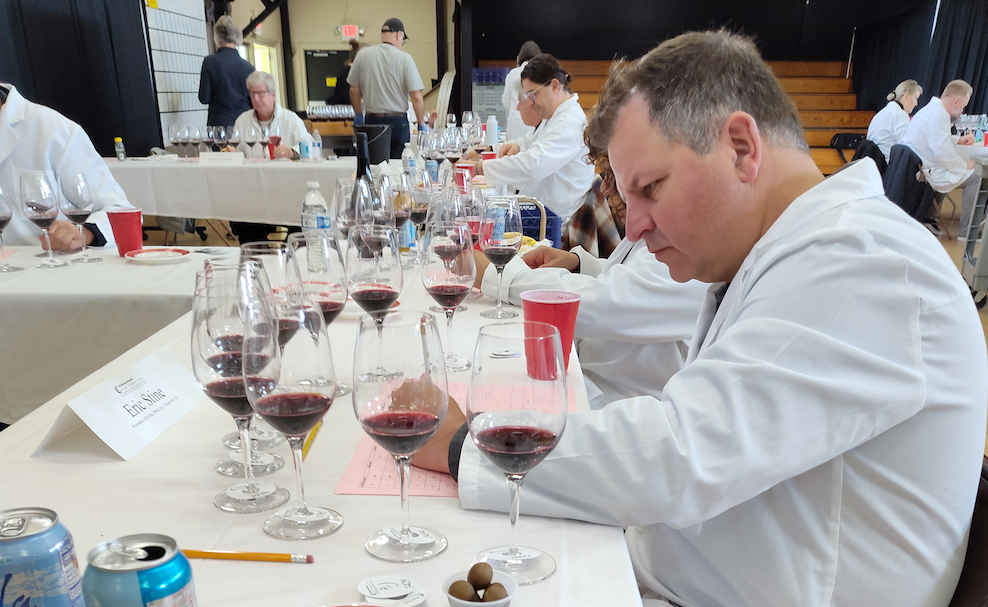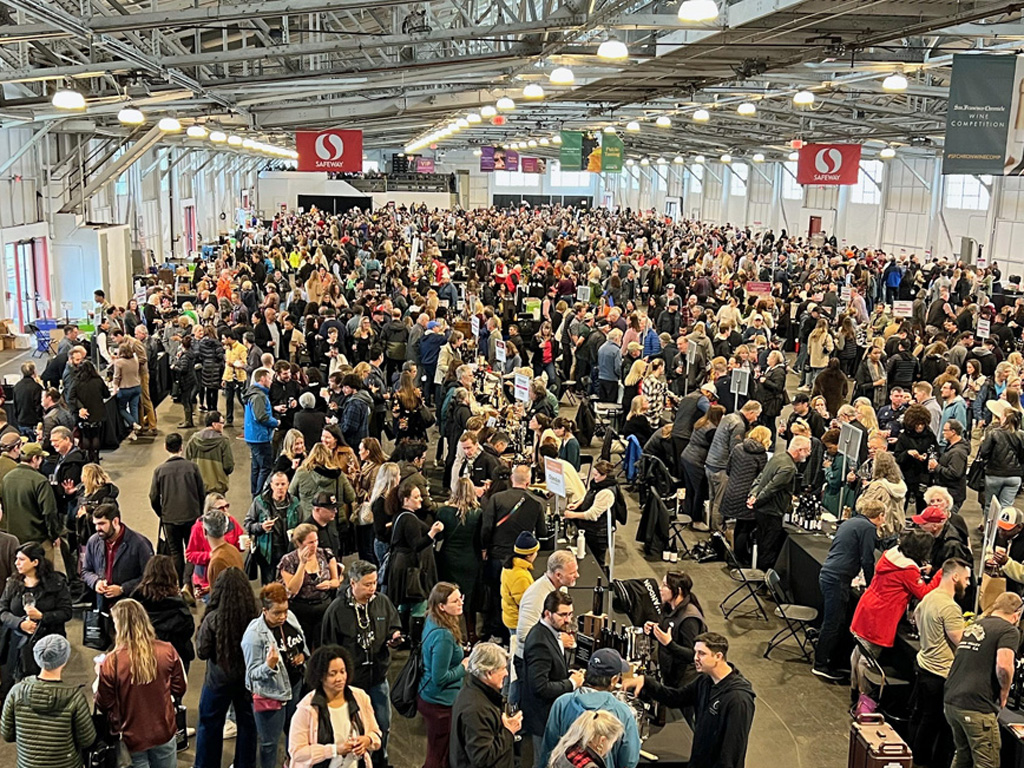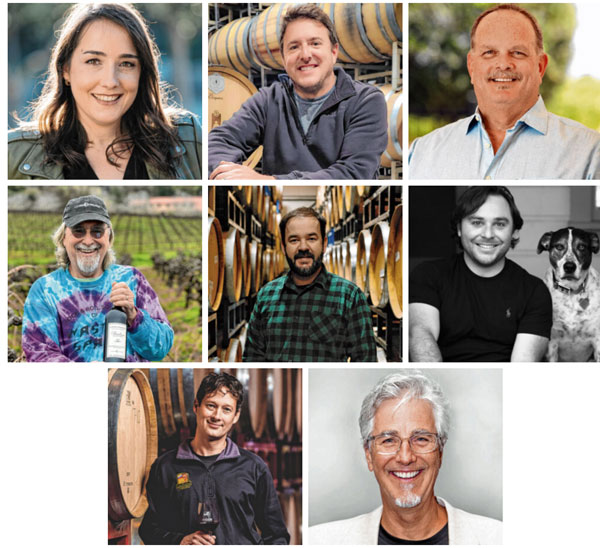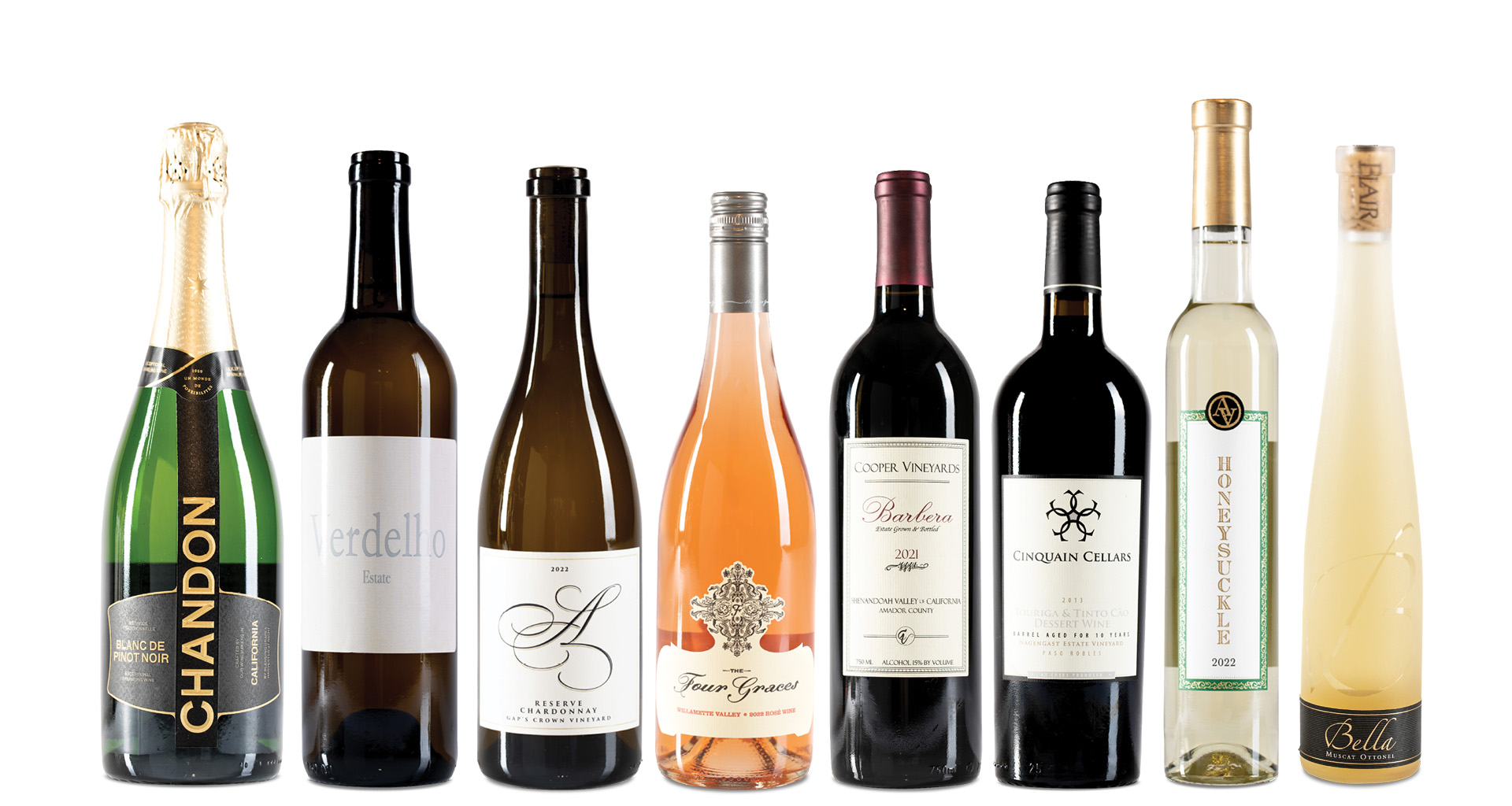Bob Ecker, Napa Valley Register, 1/29/24

A judge’s view of the San Francisco Chronicle Wine Competition
Wine judging is often considered a privileged affair complete with knowing looks, wine geek speak, bourgeois clinking and sampling an assortment of rare and expensive wines.
Although the idea is I’ll confess, glamorous, in actuality it often involves a fatigue worthy tasting of hundreds of wines at a sitting, where a few are outstanding, most are okay and some are dreadful. Although spitting the wines out is de riguer, ingesting, however briefly, tooth dyeing, mouth puckering and stomach gurgling amounts of wine can get tiresome, no matter how tasty. Rather than a beauty contest, of sorts, wine judging is akin to a celebrated dog show, so popular now on TV.
Yet rather than simply voting on the very best Bichon Frisée, Boxer or Basset Hound, judges ultimately, and blindly, must find the very best of an entire class of dissimilar wines, like Best of Show Red, carefully weighing the relative strengths, weaknesses and typicity of all contestants. It’s quite a difficult and demanding task. Even though it might sound fun, most people wouldn’t and couldn’t see it through till its conclusion and would run screaming toward their favorite cold beer.
Happily, we judges are the hardy few, and come back year after year. This was my 14th year at the prestigious San Francisco Chronicle Wine Competition, the largest of American Wines in the world. One (pre-COVID) competition saw over 7,000 wines enrolled. This year it was about 5,500.
Wines entered come from all over the United Sates and some from Mexico and Canada. This competition began here in 1982, with 200 to 300 wines from about a 20-mile radius. Bob Fraser answered an ad to help. After a four-minute interview, he was hired, and has been leading the competition ever since. At the beginning there were five judges. This year we had 52, including winemakers, educators, wine journalists, tradepeople, sales and marketing types, chefs and others, all experienced at judging.
How it works:
The San Francisco Chronicle Wine Competition, now in its 41st year, is held at the Cloverdale Citrus Fair in northern Sonoma County. Built in 1892, the cavernous, utilitarian building is usually cold in January, very good for the wines, not so much for the people. The judges first grab a lab coat and assemble for an opening group photo. Then we immediately get to work. Legions of friendly and experienced volunteers’ rollout the wines and set them up in front of panels consisting of three judges.
We’re fully stocked with water, sparkling water, wonderful bread from Healdsburg’s Costeaux French Bakery as well as olives and other snacks. My panel began by tasting 45 Viogniers up to $29.99.
The competition is similar to others except for a few important areas. First, it’s big. There are over 55 judges and thousands of wines to sample. Second, there are only medals, no scores. We give out gold, silver and bronze medals, plus Double Golds when all judges agree that a gold medal is deserving.
Third, since there are so many entries, price points are included in the judging parameters. And fourth, judges are encouraged to discuss the wines’ merit and demerits, debate scores and come up with collaborative results.
Despite the professionalism of all assembled, this is not a quiet, somber scene. On the contrary it’s often loud, with amusing anecdotes or jokes, horse trading, eye rolling, and laughter all around. But don’t fret, we’re all examining the wines in front of us. Sometimes a heated disagreement filters in, but most judges are reasonable human beings, who can play well with others.
Usually, up to 10 wines are brought out per flight. After the flight is adjudicated, the volunteers whisk away the empty glasses and the next flight is rolled in. Each judging panel is tasting different wines and differing price points. Scores are checked and rechecked. This is very complicated and it’s critical to keep things accurate.
When everything is running smoothly, it’s a finely tuned machine, and nobody does it better than Fraser and his crew. Every panel selects a Best-in-Class wine, which is sometimes a very tough decision between competing fantastic wines. Then we take a quick break and get ready for the next group to roll in.
Rick Kushman is a Sacramento-based wine judge and radio host.
“The spirit of this competition is special,” he said. “There’s a sense of joy and celebration Bob and his crew work to infuse in the competition, which helps us remember why we’re judging — for people who like wine.”
I overheard many wine words and wine-geek phrases by my fellow judges. Some made perfect sense while others were clearly meant to demonstrate the judge’s prestigious oenophilia lexicon. Frequently, I realize that a little knowledge can be a dangerous thing.
Phrases such as: “forest floor” makes sense with Pinot Noir but “I’m getting carbonic maceration,” is a bit esoteric. “This wine is toothsome,” means you can really sense the huge tannins on your teeth versus, “They used Mega Purple,” which is just plain silly, whether that additive was used or not.
In my humble opinion, we are here to judge the quality, varietal characteristics, value of each wine, and to score the wines accordingly. Occasionally a “re-pour” is requested when the judges determine a wine may be corked and a replacement may yield a much better example. Unfortunately, in most instances the wine itself is flawed and no help is coming from the alternate bottle.
After lunch we moved through weightier panels such as 55 Malbecs (a good group), Sangiovese, Petite Sirah, Cabernet or Syrah based red blends. Some of these wines can be extremely heavy and taxing, yet every entry deserves a fair shot. All in all, it ends up being about six hours of wine tasting and 110 wines or so, per day. This is each day for three days.
Spreti Valentine is the chairperson of the Los Angeles International Wine Competition.
“This is the goliath of competitions, it totally focuses on North American wines,” said Valentine. “It’s a showcase for the American way of thinking about wine.”
The afterparties are always fun, and a way to exchange gossip, hear some news, let down one’s hair (so to speak), and of course, drink and sample more good wines. Because make no doubt, all wine judges are winos at heart. We enjoy wine and like to taste it, and drink it, despite a day of judging. Last week at one party I tasted a very good, old Bulgarian wine, and an excellent, and surprising Pinot Noir by Trefethen. One winemaker brought his Petite Sirah and another opened her still delicious, 2001 old vine Zin. Then we all wake up early and do it again.
Eric Degerman is the president of Great Northwest Wine in Kennewick, Washington.
“This is like the Daytona 500, the biggest and first wine event of the year,” he said. “A very good cross section of judges, from quality control, the trade, media, all kinds of people.”
We continued evaluating wines for the three days, finding some incredible gems as well as a few…dogs. More wines, more talk, a few spills, more bread, more tannins and comments like: “This is like licking a fox,” and “It’s about Pommard Clone versus Dijon,” and “tastes like a cough drop.”
The Friday morning Sweepstakes round is the grand event and brings together the Best-in-Class winners and some 35 remaining judges. We each had about 80 wine glasses, carefully assembled in front of us. We were tasked to select the best Sparkling wine, Rosé, Specialty-sweet, White and Red wine — without spilling anything. This is the real dog show moment as the best of the best compete against each other. It’s tough deciphering a champion as all the wines were, by definition, gold medal wines.
John Compisi is another longtime wine judge and co-founder of BitesFlightsandSights.com.
“Bob Fraser has been organizing this competition for nearly 40 years,” he said. “His right arm, Anne Vercelli has been organizing and leading the volunteers for over 30 years. It remains well-oiled and displays the highest integrity for blind tasting. That’s due to Bob, Anne and the volunteers.”
The 2024 San Francisco Chronicle Wine Competition Winners:
Best Sparkling Wine: 2021 Chandon Blanc de Pinot Noir, CA ($27)
Best Dessert Wine (tie): 2013 Port-style Cinquain Cellars Touriga & Tinto Cao Dessert Wine, Paso Robles, CA ($100); 2022 Arrington Vineyards Late Harvest Gewurztraminer, Tennessee ($25)
Best Rosé Wine: 2022 The Four Graces Rosé Wine, Willamette Valley, OR ($21)
Best White Wine (tie): 2023 Las Positas Estate Verdelho, Livermore, CA ($42); 2022 Annadel Estate Winery Chardonnay, Sonoma Coast, CA ($58)
Best Red Wine: 2021 Cooper Vineyards Estate Barbera, Amador County, CA ($33)
I’m pleased to say that I chose the winning Sparkling, Rosé and White wine Sweepstakes winners. My favorite wine of all was the 2023 Las Positas Estate Verdelho from Livermore Valley, California.
Wow, what a succulent, expressive, appealing wine that truly stood out from the rest, with ample acidity balanced by amazing fruit. I can’t wait to buy a bottle.
Link to story: https://napavalleyregister.com/news/local/wine/a-judges-view-of-the-san-francisco-chronicle-wine-competition/article_7e316c2a-bbea-11ee-8d9d-f75843e3e3d4.html




